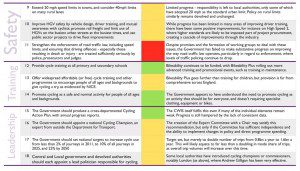APPCG CWIS report raises numerous concerns on Gov’s active travel ambitions
Launched in tandem with Bike Week UK, the All Party Parliamentary Cycling Group has today published its report on the recent inquiry into the Cycling and Walking Investment Strategy.
The inquiry, held on May 23rd, saw Transport Minister Robert Goodwill widely condemned for not taking enough of an interest in active travel, as well as receiving criticism for comments on women’s cycling. CyclingIndustry.News was in attendance and has a report of our own here.
Today’s report is authored by Michael Nattrass and Christopher Peck, coordinated by Adam Coffman and takes input from transport experts and advocates such as Rachel Aldred, Chris Boardman, Roger Geffen and many others.

In the table of contents, the APPCG document lists segments on Stronger Ambition, Greater Investment, Robust Monitoring of Progress, Improved Street Design and Safer Streets for All.
On Stronger Ambition the document talks of vague ambitions to be delivered by 2040, none of which are tied to measurable outputs.
“There was broad consensus amongst the expert panel that this target was unambitious and disappointing,” starts the report. “As Roger Geffen highlighted, this is further compounded by the draft CWIS not accounting for the projected population increases up to 2025. According to TfL’s Lilli Matson, the Government’s national target should be higher as the current projections for cycling in London would account for a third of the cycle activity required to double 2013 levels. This view was shared by the majority of the expert panel.”
Sustrans’ Jason Torrance suggested during the inquiry that the Government should consider replicating the Road Investment Strategy as a template for creating a plan for cycling. This, he said, has clear strategic aims.
This segment concludes: “To realise the Prime Minister’s ambitions and ensure cycling is now a national priority, the Government should adopt a national target to increase cycle usage to 10% of all trips by 2025, with the broader aim of matching our European neighbours over the longer term. We recommend that the Government shows stronger direction to all local partners to ensure a modal shift to cycling is central to any future strategic investments targeting local economic growth and increased wellbeing.”
Investment has quickly become the foundation of all discussion, with CyclingUK’s frightening discovery that funding will dip to just 72p per head by 2020/21. With a £10 a head goal (and rising to £20), the strategy is heading wildly in the wrong direction, believe campaigners.
The vast majority of towns and cities across England are receiving just “a fraction” of the support they need to develop cycling, bar a few Cycle City Ambition Grant recipients, said the panel of experts in May.
During the inquiry, Robert Goodwill was keen to stress that offshoot funding was being delivered for cycling, via things like Highway England’s £100 million investment.
It was pointed out, however, the enormous disparity between the Government’s £15 billion Road Investment Strategy and the £316 million allocated specifically to cycling.
On this point, CyclingUk’s Roger Geffen suggested that “access to a greater proportion of the roads and public health budget” could be justifiable given the return on investment. More detail on cycling’s ROI – the largest of all wheeled transport modes – can be found in our newly published Cycling Advocacy Resource.
LEPs and their access to the Local Growth Fund repeatedly surfaced during the inquiry as a source for further funding for cycling. While totaling £3.4 billion, this fund is not limited to cycling and unsurprisingly just 1% £36 million has been allocated to cycling, while the lion’s share, some £1.8 billion, has been spent on new road capacity.
All things considered, Robert Goodwill suggested that cycling was the recipient of nearer £7 a head, though a quick calculation shows that to be inaccurate.
On LEP investment, Both Torrance and Geffen called for the Government to “do more in addressing the significant variations in the strategic priority and therefore funding commitments given to cycling by LEPs across England.”
London, which has made unprecedented progress on safe cycling (but still has a long way to go) was flagged as a potential red herring in future analysis of Government progress.
Lilli Matson told the gathering: “On current projections (London) would account for more than a third of the Government’s target” of 1.6bn cycle stages by 2025.”
Concluding this segment, the document offers: “It is clear to us that realising the Prime Minister’s ambition to place England on a “levelfooting with countries like the Netherlands”, requires greater investment in cycling than currently committed in the draft CWIS. To build on the recent growth in cycling from investments in the few Cycling City Ambition Grant cities and London, the Government should ensure a minimum investment across England of £10 per person in cycling per year rising to £20.”
The word “robust” is telling in the next section. Titled “Robust Monitoring of Progress”, this segment centres ensuring a trained eye is kept on progress.
Pointing again to London, Lilli Matson referred to the London Cycle Design Standards, suggesting that simply calculating the kilometres of cycle track was not necessarily a good measure of progress. Echoing Roger Geffen, Matson said that such a measure would fail to discriminate between differing qualities of infrastructure. London is a perfect example of learning from mistakes, moving from paint on the road to segregated safe infrastructure. The former is widely considered a token gesture and poor use of funding.
Goodwill suggested during the inquiry that “key performance indicators, at local or regional level, was to be considered by his department, though quickly backtracked by pointing to how arbitrary targets in the Health Service have backfired in the past.
The APPCG recommendation at the close of this segment reads: “We welcome the proposed Expert Committee which will be charged with the remit to oversee the formation, implementation and evaluation of the Government’s cycling strategies. The Government should ensure the Expert Committee has sufficient independence and resources to enable it to monitor local authority performance, and, in collaboration with the Cycle Proofing Working Group, 35 improve the design of local cycle infrastructure.”
Street Design is perhaps the next key step, should funding become available. The proposal to create a set of National Design Standards was hailed as the “next logical step” by CyclingUk’s Roger Geffen and something that would ensure that no more money was wasted on low quality or dangerous design. Such a Government led direction was sought by local authorities, added Geffen during the Inquiry. Furthermore, bespoke standards add a cost burden, alongside increased margin for error in interpreting what’s acceptable.
The London Cycle Design Standards would be a strong starting point, added Lilli Maston, describing the Capital’s experience to date as a dynamic process from which much has been learned.
“These could easily form the basis of a Department for Transport endorsed national set of design standards,” she said.
In reaction to the report Cycling UK’s Policy Director, Roger Geffen MBE said: “It’s great the APPCG renewed its call for a high level of ambition and funding for cycling, as well as national design standards to ensure public money is spent well.
“Parliament, as it has in the recent past, should get behind this important report. Government needs to provide funding for cycling, national design standards to make sure public money is well spent, and revise its Highway Code in the interests of breaking down the barriers which prevents getting Britain cycling.”

The APPCG therefore recommends of the Government adopt a single set of standards to form the foundations for local authorities.
The APPCG’s Recommendations to strengthen the CWIS are:
- Strong ambition to see a cycling revolution
- Greater investment in cycling
- Clear direction that cycling is a national priority
- Robust measures to gauge progress nationally and locally
- Improving quality of cycle infrastructure design
- Deregulation of street design
- An updated Highway Code
- Action to improve enforcement of traffic laws



